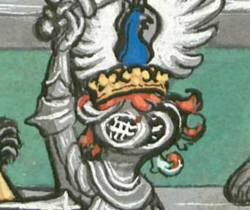|
|
You are not currently logged in. Are you accessing the unsecure (http) portal? Click here to switch to the secure portal. |
Difference between revisions of "Ludwig VI von Eyb"
| Line 31: | Line 31: | ||
| wiktenauer compilation by= | | wiktenauer compilation by= | ||
| − | | spouse = Margarete Truchseß von Pommersfelden | + | | spouse = Margarete Truchseß von <br/>Pommersfelden |
| partner = | | partner = | ||
| children = | | children = | ||
| − | | relatives = {{plainlist | Ludwig | + | | relatives = {{plainlist | Ludwig V "the elder" (father) | Anselm (brother) | Gabriel (brother) }} |
| influences = [[Nicholai de Toblem]] (?) | | influences = [[Nicholai de Toblem]] (?) | ||
| influenced = | | influenced = | ||
Revision as of 20:52, 3 January 2015
| Ludwig VI von Eyb | |
|---|---|
 | |
| Born | 10 October 1450 Castle Sommersdorf, Germany |
| Died | 21 May 1521 Castle Hartenstein, Germany (?) |
| Spouse(s) | Margarete Truchseß von Pommersfelden |
| Relative(s) |
|
| Occupation | Knight |
| Alma mater | Erfurt University (?) |
| Influences | Nicholai de Toblem (?) |
| Genres | |
| Language | Early New High German |
| Manuscript(s) | |
Ludwig (VI) von Eyb "the Younger" (1450 - 1521)[citation needed] was a 16th century German knight from Hartenstein, Germany. He seems to have been an accomplished soldier, including fighting in the Landshut War of Succession in 1504.[citation needed] He also produced a fencing manual as well as at least one tournament book (the Cgm 961, 1519).
Among Eyb's writings is the MS B.26, which is similar to the Codex 5278 in that it consists of both a copy of Konrad Kyeser's popular treatise on siege warfare Bellifortis ("Battle Strength") and a version of the treatise known as die Blume des Kampfes ("The Flower of Battle"). This manuscript complex might be based on the tradition of 14th century Italian master Fiore de'i Liberi given that his works include considerable technical overlap, but it is equally possible that they represent an earlier German tradition of which Fiore was himself an initiate. Eyb's work is the only currently known member of the group which contains detailed descriptive text as well as illustrations, and significantly the text is not translated from Liberi's own treatises.

